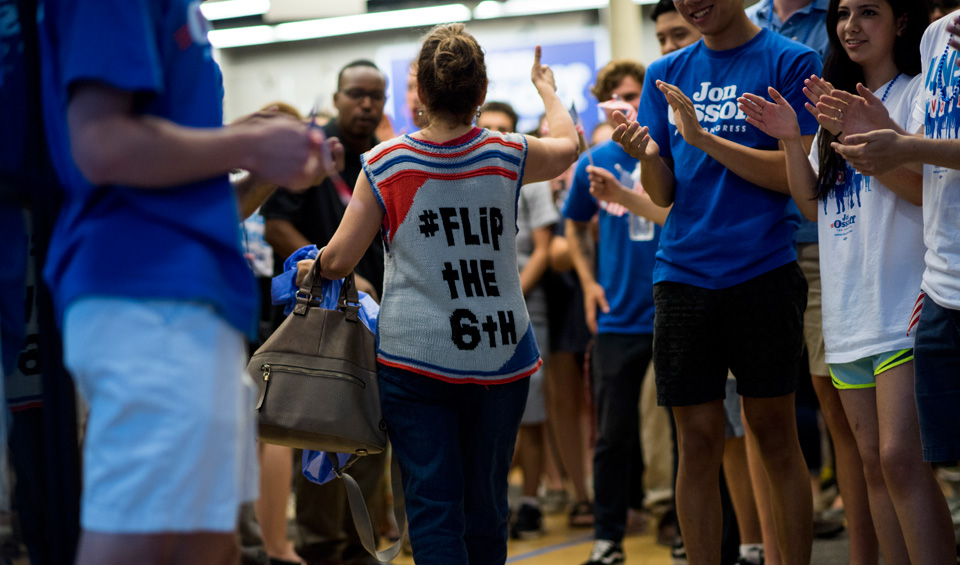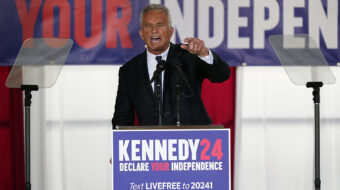
The string of Democratic Party losses in special elections this past spring brought to the surface tactical disagreements within the party and the broader progressive movements.
Most of these debates center on the question of what is the best way to oust the Republican right-wing majority in the 2018 mid-term elections and advance a progressive agenda. Going even further, some progressives argue the time is now ripe to oust corporate Democrats and take over the Democratic Party altogether, or even to split and form a new third party.
The 2018 elections are pivotal. The nation faces a Trump and GOP-induced constitutional crisis. Nothing less than the defense of democracy and halting the drift toward authoritarianism is at stake.
Victory requires the most flexible tactics and broadest unity and cooperation to engage tens of millions of voters. Neither left nor center within and outside the Democratic Party can do this alone. Furthermore, any split from the Democratic Party at this moment would be disastrous for the entire resistance.
Democrats need 24 seats to re-claim a House majority. The Democratic Congressional Campaign Committee (DCCC) is targeting 79 GOP-controlled districts to flip, many of which Hillary Clinton won in 2016.
The Koch Brothers will spend $400 million protecting the GOP majority. This is a sober reminder of the titanic battle ahead.
Over-performance or failure?
Despite the recent special election defeats, Democratic candidates either outperformed Trump’s margin of victory or the last GOP vote in their particular congressional districts.
Had the Democratic Party poured resources into races in Kansas, Montana, and South Carolina in support of its adopted 50-state strategy, would the Democratic challenger have won? That’s a fair question.
In the case of Jon Ossoff’s loss to Republican Karen Handel in Georgia’s 6th Congressional District, there were enough resources and ground troops to win. What’s being debated in this case is Ossoff’s program and messaging, particular his reluctance to endorse a single-payer health care system.
Some faulted the Democratic Party establishment and Ossoff himself, arguing he was a corporate Democrat who campaigned on a vague appeal. Instead, the claim goes, a progressive platform of single-payer healthcare, free education, and taxing the rich was needed to inspire turnout – and is also what’s required to prevail in 2018.
It’s not enough to be against Trump. Acknowledging the criticism and affirming the need for a clear alternative to the GOP agenda, Democrats began unrolling a “Better Deal” for America. The program calls for creating millions of jobs through a massive infrastructure plan, a $15 minimum wage and job training, and includes single-payer among the solutions for the health care crisis.
Factors in the loss
Georgia’s 6th Congressional District was purposely gerrymandered to be a reliably conservative GOP district and elected Republicans to Congress for 40 years. In 2016, former Rep. Tom Price won by 22 percent, although Trump beat Clinton by just 1 percent.
Less than six months later, Ossoff lost by 4 percent, winning approximately 10 percent of GOP voters while taking a majority of the independent vote.
The GOP enjoys a deep voter allegiance in the 6th District. Handel won on many of the same appeals Trump exploited in 2016: fear, racial resentment, xenophobia, and Islamophobia.
Ossoff was characterized as an outsider with support from Hollywood elites. (Although he grew up there, Ossoff did live outside the district at the time of the election.)
He was tied to House Minority Leader Rep. Nancy Pelosi, who, like Hillary Clinton, has been demonized with misogynistic attacks. References to Pelosi’s San Francisco district were coded appeals to homophobia.
Since Ossoff is Jewish, you have to wonder how much anti-Semitism might also have played a role.
New voter suppression laws in Georgia clearly impacted turnout. Civil rights groups have filed at least seven lawsuits against state and local officials to contest them.
Dee Hunter, director of the Civil Rights Center, believes Ossoff would have won outright in the first round had it not been for voter suppression.
Investigative journalist Greg Palast reported the New Georgia Project registered 86,000 new voters. But 40,000 of these fresh registrants magically “vanished” somewhere at the Board of Elections, including many in the Georgia 6th.
Given all this, it is remarkable Ossoff came so close to winning.
Even though he lost, the character of the Ossoff campaign’s base of support is worth noting. It was a broad and diverse coalition of women, African Americans, Asians, Latinos, youth, and labor, including new activists outraged by the election of Trump. Ossoff took 40 percent of the white vote.
The Democratic establishment had for all intents abandoned the district since 1979. Conceding the Georgia 6th and other districts like it to the GOP proved to be a huge mistake.
An electoral infrastructure is now being built largely from scratch in the district. It will take time to re-engage and educate voters, especially those who feel their voice doesn’t matter. Even with 12,000 ground troops and a record amount of money, less than half (48 percent) of voters went to the polls.
Referring to the work of Democratic women organized into a group called Pave It Blue, state Sen. Nan Orrock characterizes the “prolonged, months-long battle of trying to flip the 6th” as “laying the groundwork” to turn the whole state blue in the future.
Colors of change in Georgia
The 6th District and Georgia as a whole are changing, but not overnight. A big influx of African-American, Latino, and Asian residents is creating new alliances and shifting politics.
The efforts of groups like Pave It Blue are focused on painstakingly building multi-racial unity, diverse networks, and a grassroots ground operation to expand the electorate and challenge the influence of right-wing ideas.
This is being combined with a struggle against gerrymandering and voter suppression.
The emergence of this new multi-racial democratic movement statewide is driving changes in the state legislature and opens the possibility of electing Stacey Abrams as governor in 2018. If elected, Abrams would be the nation’s first African-American woman governor.
The 6th District special election was a snapshot of this process. Although Ossoff stood on the progressive side of the political spectrum, he moderated his message to assemble a winning coalition.
The Nation writes, “These women, and their male allies (in the campaign), don’t understand why the Ossoff race has been framed by some critics as the campaign of a corporate Democrat powered by party elites.” Indivisible co-founder Amy Nosek, who was a supporter of Sen. Bernie Sanders in 2016, said, “Jon [Ossoff] is reaching out to everyone, and we need that here.” Continuing, she said, “There’s no way the 6th District is ready for a Bernie right now. I think of Jon as a pragmatic progressive, and that’s what we need.”

The implications of the Ossoff race are clear for the 2018 elections: One size doesn’t fit all, and politics are in flux.
The balance of political forces has to be carefully measured in each district. In some places, candidates will have no problem openly advocating for single-payer, free college tuition, and taxing the rich. In others, it will be more difficult – especially in those districts gerrymandered for GOP candidates. Here, putting together winning electoral coalitions may mean including moderate Republicans.
Single-payer and 2018
Some progressives harshly criticized Ossoff for not openly supporting single-payer legislation. Without question, it’s the only long-term solution to the health care crisis.
Ossoff felt he couldn’t push single-payer, though, because of the nature of the broad coalition he was building, which included disaffected GOP voters.
But things are changing. Obamacare created a paradigm shift, and now a majority of Americans think government has the responsibility to ensure health care for all.
Simultaneously, there is growing consensus in the Democratic Party for single-payer. Yet differences remain over how to get to single-payer and what the relationship would be between it and established insurance plans negotiated by unions. Public sentiment is changing rapidly, but single payer doesn’t yet enjoy majority support. Therefore, a candidate’s position on single-payer can’t be a litmus test as to whether they deserve support.
Trump announced his intention to go all out to bolster GOP congressional majorities in 2018 to repeal Obamacare, a great, yet limited achievement of the working class and progressive movements. The battle lines have been drawn.
It will require flexible tactics to win in districts like the Georgia 6th. Unity and cooperation are needed to block Obamacare’s repeal, prevent its sabotage, and demand a public option as the next step in reform.
At the same time, independent grassroots movements and coalitions – beginning with the labor movement – must be built. This includes convincing a majority of voters that single-payer is the only viable, long-term solution to the health care crisis.
Potential for progressive advance
There is general unity on the need for a 50-state strategy among the diverse forces making up the Democratic Party coalition. Moveon.org and other groups joined the DNC in the “Resistance Summer” project in Arizona, Massachusetts, Michigan, Kansas and South Dakota.
A key aspect of the resistance to Trump and the GOP is the unbroken unity of congressional Democrats and their interaction with the mass upsurge.
Central to this development is a temporary multi-class alliance whose main purpose is to defeat the right. Along with cooperation, however, there are always going to be contradictions, antagonisms, and internal struggles in such an alliance. That is a given.
But moderate and establishment forces within the Democratic Party are not static. They are responding to the left, the mass upsurge, and changing public opinion, even if that response is at times halting and inconsistent. This was evident in the platform adopted at the Democratic National Convention in 2016, widely considered the most progressive ever of any major party.
New opportunities are opening up for progressive politics despite the immense dangers and daunting challenges that characterize the current period. Broad and flexible tactics, if pursued, have the possibility of halting the assault on democracy, defeating the right, and advancing a progressive agenda all at the same time.

MOST POPULAR TODAY


Zionist organizations leading campaign to stop ceasefire resolutions in D.C. area

Communist Karol Cariola elected president of Chile’s legislature

Afghanistan’s socialist years: The promising future killed off by U.S. imperialism

High Court essentially bans demonstrations, freedom of assembly in Deep South






Comments